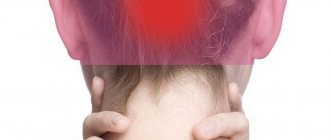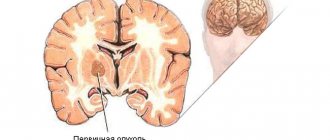Headache and soreness in the right eye area may indicate serious health problems.
Receptors responsible for pain are located in the veins, blood vessels and lining of the brain.
We recommend reading: Headache and blurred vision
This can make it feel like only half of your face and head are hurting. Pain on the right side often occurs due to mechanical injury and migraines. It is extremely rare that the right hemisphere of the head and eyes may hurt due to the presence of a malignant tumor on the right side. In any case, if you experience pain and discomfort, you must visit a specialist to make an accurate diagnosis and eliminate the problem.
Causes
Pain in the area of the right eye and head can occur for many reasons, but there are several main ones, the manifestation of which cannot be self-medicated. Causes of prolonged headaches and discomfort:
- Prolonged fatigue and being under severe stress. Soreness may be accompanied by throbbing and discomfort in the area of the right eye. It often occurs when spending a long time at the computer or in front of the TV. In this case, pain on the right side can occur in the morning or evening and manifest itself as a stabbing sensation in the temple or forehead area.
- Bruises of various types. The slightest blow can lead to concussions, which ultimately lead to brain diseases.
- Glaucoma and other eye diseases. If one eye is affected, the patient experiences severe discomfort. The pathology may be accompanied by a prickly sensation in the eyes, and the image begins to float.
- Incorrect selection of contact optics (lenses or glasses). When wearing incorrectly selected optical accessories, discomfort may occur in one or both eyes, migraines may develop, lacrimation increases, and the eyes quickly become tired.
- Spasmodic attacks in blood vessels. If the load is not performed correctly, compression or damage to blood vessels occurs in the cervical spine. As a result of such a clamp, pain may occur in the right side of the head, minor hemorrhages causing discomfort. A migraine may develop, with pain radiating to the right eye. Additionally, nausea, absent-mindedness, and slight loss may appear.
- Osteochondrosis – can cause headaches, dizziness and pain in the neck and eyes. Symptoms can appear with varying intensity, both on the right side and on the left.
- Hematoma inside the skull, malignant formations, meningitis and a pre-stroke condition - all this can provoke pain in the head and eye area on the right side. Additionally, with these conditions, the patient may experience significant weight loss, morning sickness, and frequent cramps.
- Eye injuries and infectious diseases can also cause pain on the right side.
- Colds and diseases of the respiratory system.
- Damage to the vascular system.
Treatment methods
At the Clinical Brain Institute, treatment is selected individually. The scheme will include two main stages - getting rid of the main cause of the disease and its symptoms. Depending on the stage of the disease and its clinical manifestations, treatment is carried out at home or in a hospital. Several stages can be assigned, which are combined with each other.
- Drug treatment is the first stage for any disease. For headaches that radiate to the right eye, painkillers and antispasmodics, vitamins, and drugs to improve cerebral circulation are effective. In case of high blood pressure, infectious diseases, metabolic pathologies, you should take specific medications to improve the condition, which are prescribed only by a doctor.
- Physiotherapy is an equally important stage of treatment. It is effective for chronic pain and old inflammatory processes, consequences of injuries. Exposure to heat, magnetic radiation, electrical impulses irritates tissues, stimulates blood circulation and innervation.
- Massage is one of the methods of treating headaches associated with muscle spasms, diseases of the cervical spine, and the consequences of injuries. It is important to contact a specialist who will take into account all the physiological characteristics of the patient and help get rid of painful sensations. For acute inflammation, the method is not used.
- Treatment of eye diseases is prescribed by an ophthalmologist. He may prescribe glasses or contact lenses, which are made individually, depending on the results of the examination. Chronic diseases may require the use of antibiotics, anti-inflammatory and specific groups of drugs.
Surgical treatment methods are rarely used. The need for them arises with tumors and hematomas that compress nerve tissue, as well as with other neoplasms. At the Clinical Institute of the Brain you can get detailed advice on headache treatment methods, undergo examinations and receive competent advice from specialists. It is important to contact early, while diagnosis and treatment can improve your well-being, and not wait for irreversible changes.
Clinical Brain Institute Rating: 3/5 — 4 votes
Share article on social networks
What to do if a symptom occurs
To alleviate pain before visiting a specialist, the first step is to restore normal sleep and give the body a rest. To do this, you can take an infusion of valerian. You should avoid drinking strong coffee drinks that contain caffeine. Instead, it is better to brew tea with the addition of thyme, mint and chamomile. You can reduce pain by applying cold to the place where it appears; for this it is better to make a compress using ice.
During the period of migraine and severe pain on the right side of the head, discomfort can be reduced with the help of special massage actions. To do this, you should very carefully massage the area where the pain is coming from with your fingers. The duration of such a massage should be at least 10 minutes. It must be remembered that in cases where the pain is caused by tumors, massage is prohibited.
You also need to know that folk remedies can help relieve discomfort only with mild symptoms. In the event of cerebral hemorrhages, vomiting, or dizziness, self-medication is prohibited. In such cases, effective treatment should only be determined by a specialist, since such manifestations cannot always be cured with medication.
It is important to understand that the first step is to determine the reason why the pain appeared on the right side. It is necessary to undergo an examination consisting of the following procedures:
- a deep blood test that allows you to see all possible deviations from the norm;
- computed tomography - to identify possible tumors and problems with blood vessels that cause pain;
- ophthalmological examination – necessary to exclude problems with the visual organs.
Further prescription of therapeutic therapy will directly depend on the cause of pain. During the examination, in case of short-term pain, specialists allow you to take painkillers. Often the patient is recommended to take Analgin, Spasmalgon or Citramon, as they relieve spasms, help dilate blood vessels and stop pain.
If you have a severe migraine on the right side of your head, you should take an anti-inflammatory drug that will help eliminate fatigue and relieve pain. It is important to increase the amount of water you drink and get more rest, preferably in the fresh air.
How to eliminate pain?
To relieve painful symptoms, it is necessary to exclude any irritants that only provoke its intensification, as well as ventilate the room and get proper rest.
If it hurts a lot, you can take a painkiller, but only with your doctor's permission. In any case, pain cannot be tolerated. These are signs of many serious diseases; there may be other complications
It is important to find out the cause of such manifestations in any case.
Effective for migraines: no-spa, paracetamol, acetyl. With elevated blood pressure, stabilization is necessary. Once the underlying cause is eliminated, the headache attacks will go away.
Complications
Most often, the right side of the head and the right eye hurt due to migraine. This disorder causes pain in the right temporal lobe; with strong tension in the temporal artery, the pain spreads to the eye. In rare cases, the pain spreads to the heart area, which can provoke frequent urination.
Migraines can cause discomfort, which is accompanied by nausea and vomiting. Dizziness, severe drowsiness and increased fatigue may occur.
You need to understand that a distinctive feature of migraine is its manifestation in the morning. Along with the pain, severe irritability and nervousness may occur. Moreover, such manifestations quickly disappear after taking painkillers.
What diseases cause headaches in the forehead and eyes?
Headaches in the forehead and eyes are quite common. What could be their reason and what to do to help yourself?
Migraine
The most common cause of such specific localization of pain is migraine. Many people believe that a migraine is just a headache. In reality, a migraine attack is not only an unpleasant sensation. An attack usually consists of 4 stages or phases. A migraine attack develops as a result of the action of provoking factors and only in the presence of a genetic predisposition.
Provocateurs include weather changes, physical stress and emotional stress, certain foods (smoked meats, cheeses, nuts, chocolate, seafood) and drinks (champagne, beer, wine, especially red), skipping meals, lack of fluid in the body, excess or lack of sleep.
A migraine attack is manifested by throbbing or pressing pain in the forehead, temple, and eyes on one side, the duration of which is 4-72 hours. The side of the pain may change from attack to attack. Migraine headaches are accompanied by nausea, less often - vomiting, intolerance to loud sounds, bright light, strong odors, which increase the pain.
Before an attack, a so-called migraine aura may occur, which is manifested by various visual (flashes before the eyes, loss of half of the visual field), auditory (noise, ringing in the ears), olfactory, gustatory and other sensory phenomena.
For rare (1-2 times a month) and mild migraine attacks, it is necessary to select medications to successfully relieve pain. For more frequent and/or more severe attacks (high intensity of pain and ineffectiveness of drugs to relieve the attack), preventive treatment lasting from 6 to 12 months is necessary, which is selected only by a doctor, taking into account the individual characteristics of the patient.
Cluster headaches
This disease is much rarer than migraine. It manifests itself as very intense pain in the temple and eye area on one side, lasting from 15 minutes to 3 hours (usually 30-60 minutes). They are accompanied by lacrimation and redness of the eye on the side of the pain, swelling of the eyelid, congestion and nasal discharge, and a painful attack may be accompanied by psychomotor agitation. Attacks of pain can occur several times a day, very often they develop at night, between 11 and 3 am.
Cluster headaches are characterized by exacerbations (“bundle” or cluster), which can last from 2 weeks to 3 months. More often, exacerbations occur in spring and autumn. In rare cases, cluster headaches are chronic.
If a patient has cluster headaches, it is necessary to prescribe preventive treatment during the “cluster” period and use drugs that relieve the attack. Each patient needs dynamic monitoring during the treatment period.
Paroxysmal hemicrania
This is an even rarer type of headache and can sometimes be confused with a migraine due to the throbbing nature of the pain. However, with this disease, attacks are much shorter, lasting from 2 to 30 minutes, and can be repeated up to 5 times a day. A characteristic sign of paroxysmal hemicrania is a decrease in pain after taking the drug indomethacin.
Conclusion
There are many types of headaches that are localized in the forehead and eye area. Each has a specific mechanism of occurrence and treatment algorithm. We have considered only the most basic types. And, of course, as readers understand, the patient cannot independently figure out what type of headache bothers him. If you have a headache, you should consult a neurologist specializing in the treatment of headaches or a cephalgologist. There is a Pain Treatment Clinic in Saratov where they can help you. To make an appointment, call +7 (8452) 49-30-49.
Prevention
Most diseases cause pain, which is almost impossible to prevent. In this regard, there are no precise preventive measures. To prevent the development of unpleasant sensations, you should protect the body from overexertion. Mental and physical fatigue can negatively affect people's health.
To prevent severe headaches, you should spend more time outdoors. Also, regular exposure to the street will contribute to the overall strengthening of the body.
Attention should be paid to a healthy lifestyle, especially for people who have sedentary jobs. Adequate sleep is also important, the duration of which should be at least 8 hours a day. This time is enough for the body to regain strength and rest. To ease pain, you can, if possible, replace trips on public transport with walking.
It must be remembered that the more the patient protects himself from stress and various strains, the less pain will appear in the right side of the head and eyes.
Optic neuritis
The pathology is an inflammation of the second cranial nerve. The general clinical picture is similar to the manifestation of papilloedema, but without the characteristic increase in intracranial pressure. The most common cause is pathology of the central nervous system (selective damage to the myelin sheath), less often - sinusitis, inflammation of the orbital contents.
Pain inside the eye is the main symptom of the pathology, intensifying with its movement. Additionally, the patient complains of changes in the perception of shades, deterioration of vision, and the appearance of pointless images before the eyes.
Diagnosis of the disease is quite difficult; instrumental research methods cannot always reveal characteristic changes in the fundus. The task is to determine the presence of multiple sclerosis, which is a provoking factor of the disease.
Diagnostic features
If you have a headache that spreads to the area of your right eye, you need to see a doctor for a diagnosis. To do this, an analysis of the patient's medical history is carried out.
At the doctor
The doctor may also prescribe additional procedures:
- hormone analysis;
- electrocardiogram;
- computed tomography of the brain;
- MRI;
- general blood analysis.
Magnetic resonance imaging
It is important to carry out diagnosis in a timely manner, since many patients, in order to get rid of painful sensations, take painkillers, the active components of which can hide the symptoms of dangerous pathologies










